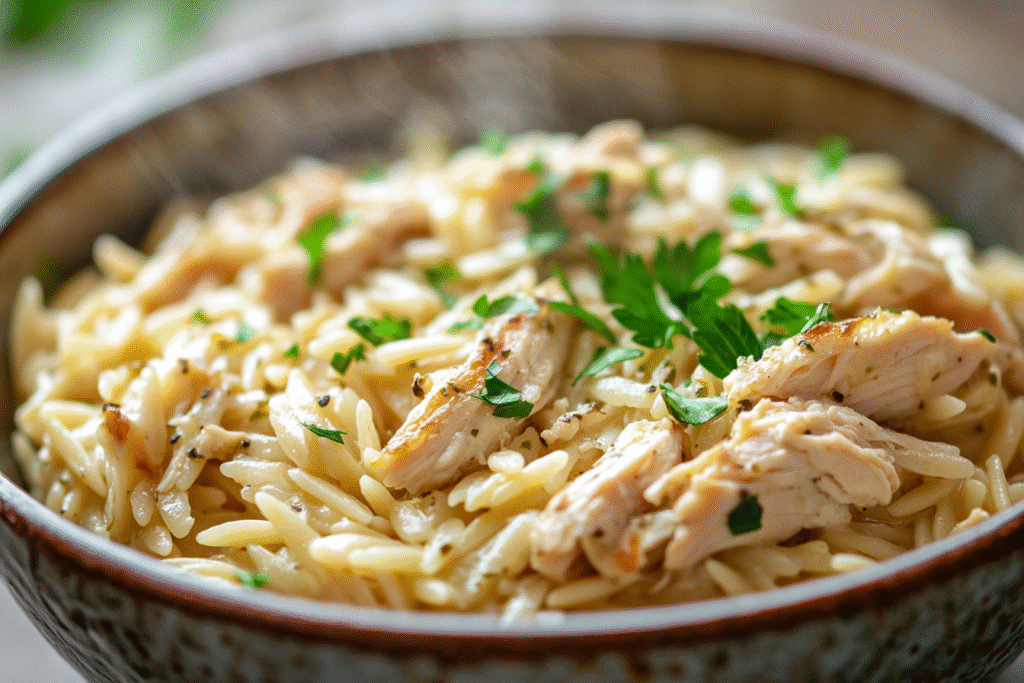If there’s a way to combine minimal prep, maximum flavor, and ultimate comfort in one pot, this is it. Slow Cooker Mustard Herb Chicken and Orzo is a modern twist on rustic home cooking—one that leans on pantry staples like Dijon mustard and dried herbs while delivering a meal that tastes like you spent hours tending to a stovetop. Tender chicken slow-simmered in a mustardy broth, cozy orzo soaking up every drop of flavor, and a hint of brightness from lemon and herbs—this is a meal built for chilly nights, long workdays, or anytime you just want to come home to something deeply satisfying.
The Backbone of the Dish: Choosing the Right Chicken
Boneless, skinless chicken thighs are the star here, and for good reason. They’re hard to overcook, infuse the orzo with flavor as they break down, and stay tender and juicy over several hours in the slow cooker. They also hold up better than breasts when shredded, giving the final dish a rich, almost stew-like consistency.
If you prefer white meat, boneless, skinless chicken breasts can be used, but be cautious: cook on low and check for doneness early (around the 3-hour mark) to prevent drying out. For a more rustic touch, bone-in thighs are another excellent option—they add depth to the broth, though you’ll need to remove the bones before adding the orzo near the end.

The Flavor Boost: Why Mustard Works So Well
Dijon mustard might seem like an unexpected ingredient in a slow cooker chicken recipe, but here, it’s a game-changer. It adds tang, warmth, and complexity without overpowering the dish. Combined with garlic, herbs, and broth, mustard becomes a savory backbone that permeates the chicken and orzo as everything cooks together.
Use Dijon for the most balanced flavor—it’s smooth, slightly spicy, and won’t curdle or break during long cooking times. Avoid yellow mustard, which is too sharp and acidic for this dish, and whole grain mustard, which adds a gritty texture that doesn’t quite suit the silky orzo.
Dry vs. Fresh: Navigating the Herb Mix
A trio of herbs—thyme, rosemary, and parsley—brings a woodsy, savory foundation to this dish. Dried herbs are used in the slow cooker phase, holding up well to long cook times and infusing the broth with their essential oils. Fresh parsley is added just before serving for color and brightness.
You can swap in Italian seasoning if you’re short on individual herbs. A good substitute blend includes thyme, oregano, basil, and rosemary.
Why Orzo Works in the Slow Cooker (and When to Add It)
Orzo, that tiny rice-shaped pasta, is the unsung hero of this dish. It cooks directly in the slow cooker, soaking up all the herby, mustardy broth until it turns plump and silky. The key to getting it right is timing.
Add the orzo in the last 30 minutes of cooking. Add it too early and it’ll turn mushy. Too late and it won’t cook through. Keep an eye on it—if you’re using a particularly hot slow cooker, check it at the 20-minute mark.
Another tip: stir once or twice during this final phase to prevent clumping and ensure even cooking.

Equipment Tips: Simplicity Wins
All you need is:
- A 4- to 6-quart slow cooker
- A whisk for the broth and mustard mixture
- Tongs for transferring the cooked chicken
- A fork or two for shredding
- A citrus zester or grater if using fresh lemon zest
No need for browning pans, stovetop pots, or multiple dishes—this is a true one-pot meal from start to finish.
Smart Substitutions for Dietary Needs
This recipe is as flexible as it is flavorful. Here’s how to adjust it to fit different diets:
- Gluten-Free: Use gluten-free orzo (yes, it exists!) or substitute with cooked rice added just before serving.
- Dairy-Free: The original recipe is naturally dairy-free, so no changes needed unless you decide to add cheese at the end.
- Low-Carb/Keto: Replace the orzo with cauliflower rice added at the end of cooking (use already-cooked or microwaved cauliflower rice to avoid watering down the sauce).
Make-Ahead Tips and Storage Strategy
To prep ahead for an even faster start:
- Mix the mustard broth the night before and store it in the fridge.
- Trim and season the chicken in advance and refrigerate in a sealed container.
- Pre-measure your orzo so it’s ready to toss in at the right time.
Once cooked, this dish holds up incredibly well:
- Store leftovers in the fridge for up to 4 days.
- Freeze in airtight containers for up to 3 months.
- Reheat gently on the stovetop or in the microwave with a splash of broth or water to loosen.
Flavor Upgrades and Custom Touches
Once you’ve mastered the basic version, feel free to make it your own:
- Add a splash of white wine to the broth for extra depth.
- Stir in a few tablespoons of grated Parmesan just before serving for a creamy, savory kick.
- Finish with a drizzle of olive oil or a few pats of butter for richness.
- Add spinach or kale in the final 10 minutes for a one-pot green boost.
- Top with a sprinkle of crushed red pepper for heat.
Ingredients
For the Chicken and Broth Base
- 2 pounds boneless, skinless chicken thighs (or breasts)
- 2 1/2 cups low-sodium chicken broth
- 2 tablespoons Dijon mustard
- 1 tablespoon olive oil
- 4 garlic cloves, minced
- 1 teaspoon dried thyme
- 1/2 teaspoon dried rosemary
- 1/2 teaspoon salt (adjust to taste)
- 1/2 teaspoon black pepper
For the Orzo and Finishing
- 1 cup dry orzo pasta
- 1 tablespoon lemon juice (plus optional zest)
- 2 tablespoons fresh chopped parsley
- Optional: 1/4 cup grated Parmesan cheese (for a creamy finish)
Instructions
- Make the Broth Base
In a medium bowl, whisk together the chicken broth, Dijon mustard, olive oil, garlic, thyme, rosemary, salt, and pepper until well combined. - Assemble in the Slow Cooker
Place the chicken thighs in the bottom of the slow cooker in a single layer. Pour the mustard herb broth mixture over the chicken, ensuring it’s mostly submerged. - Cook Low and Slow
Cover and cook on low for 4–6 hours or high for 2.5–3.5 hours, until the chicken is tender and easily pulls apart with a fork. - Shred the Chicken
Use tongs to remove the chicken to a plate. Shred it with two forks and return it to the slow cooker, stirring to distribute evenly. - Add the Orzo
Stir in the dry orzo and lemon juice. Cover again and cook on high for 25–30 minutes, stirring once halfway through, until the orzo is tender and has absorbed most of the liquid. Add a bit more broth if needed for a saucier consistency. - Finish and Serve
Stir in fresh parsley, lemon zest (if using), and Parmesan (if desired). Taste and adjust seasoning. Serve warm with extra lemon wedges or crusty bread.
Storage and Reheating
- Refrigerate: Cool and store in airtight containers up to 4 days.
- Freeze: Store in freezer-safe bags or containers for up to 3 months. Thaw in the fridge overnight before reheating.
- Reheat: Add a splash of broth or water and warm gently on the stove or microwave until hot.
Serving Ideas
This dish is hearty and satisfying all on its own, but here are a few great companions:
- Arugula salad with lemon vinaigrette for a peppery contrast.
- Steamed green beans or broccoli for added freshness.
- Toasted garlic bread for dipping in the herby sauce.
- A glass of crisp white wine to complement the mustard and herbs.
Comparisons and Variations
- Versus Risotto: Orzo mimics the creamy texture of risotto without all the stirring. It’s faster, less fussy, and more forgiving.
- Versus Pasta Bake: This isn’t baked, but you could transfer the finished dish to a casserole dish, top with cheese, and broil for a golden crust.
- Versus Soup: This version is thicker and more stew-like. For a soupier result, add an extra 1/2 to 1 cup broth when adding the orzo.
If you’re craving a one-pot meal that’s as comforting as it is flavorful, this Slow Cooker Mustard Herb Chicken and Orzo is your answer. It’s hearty, herby, and just the right amount of tangy—proof that simple ingredients really can create something extraordinary.
